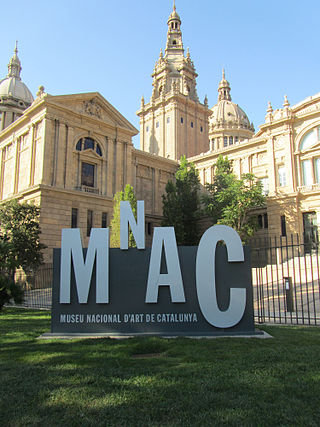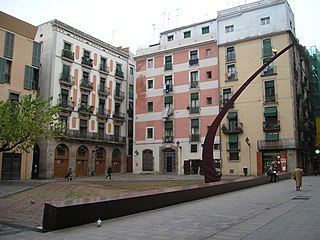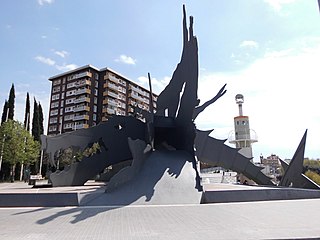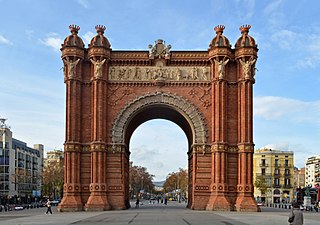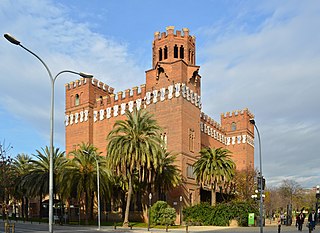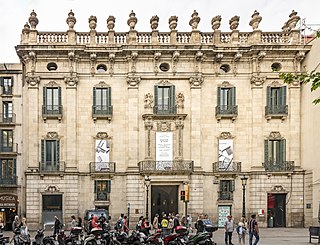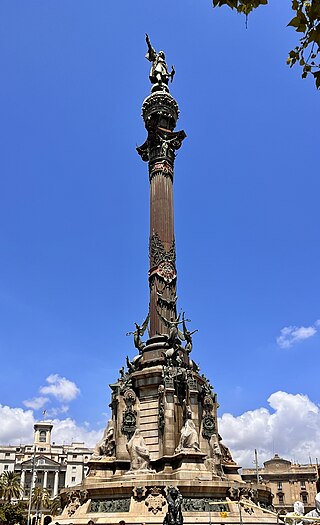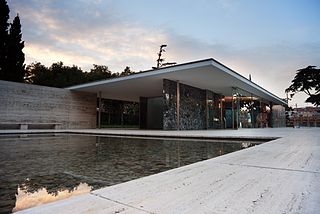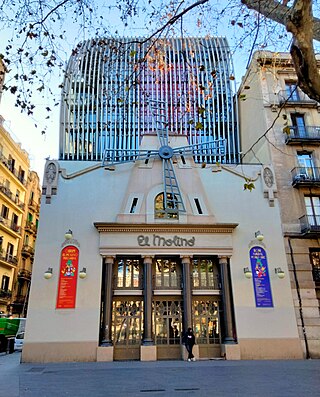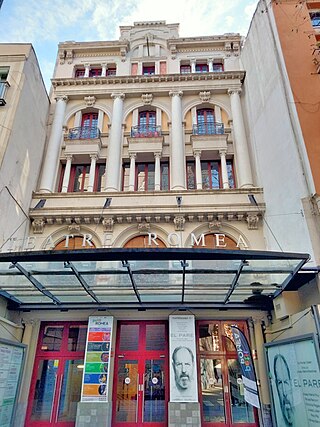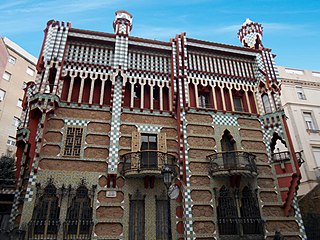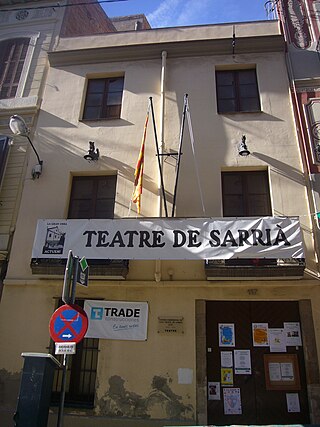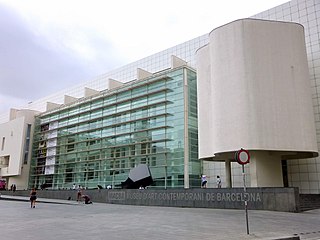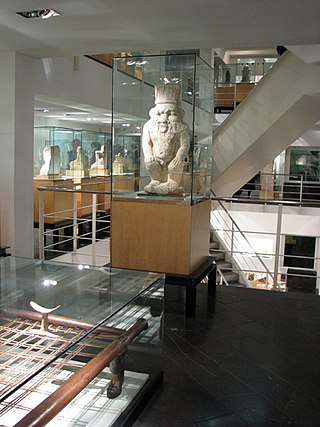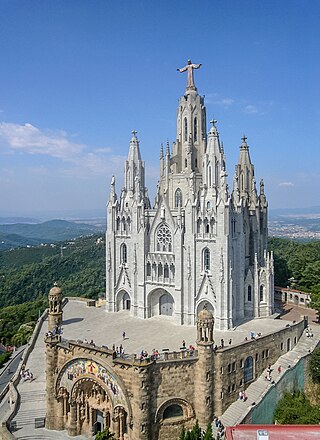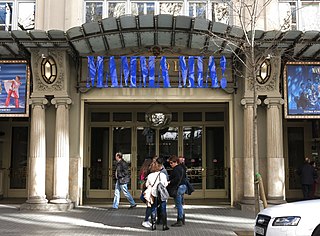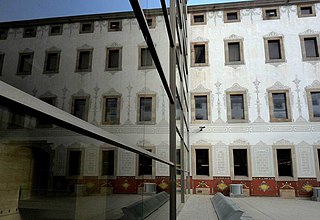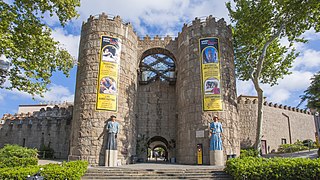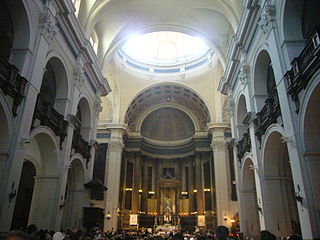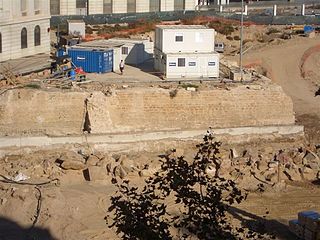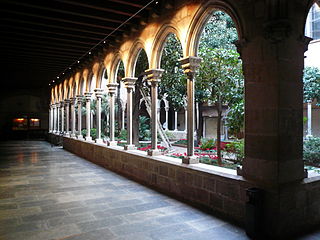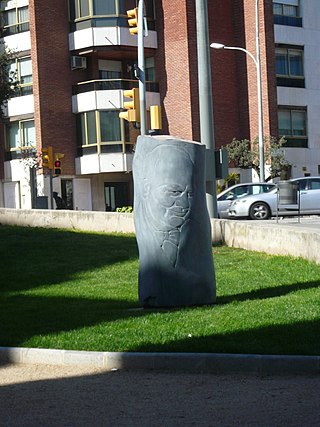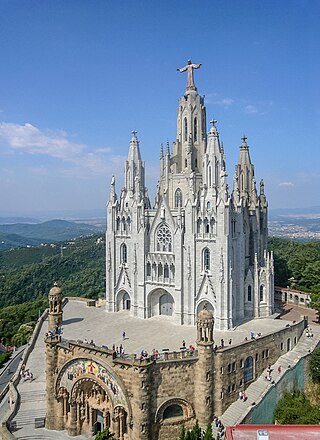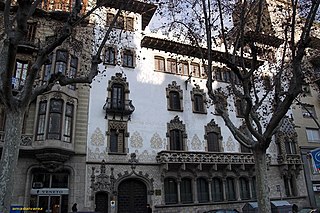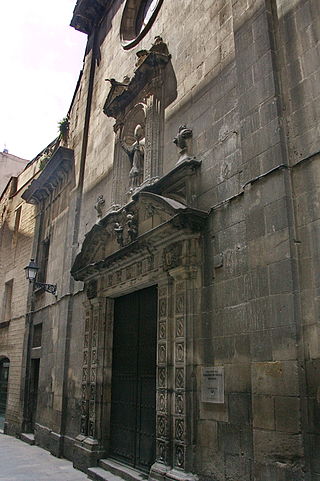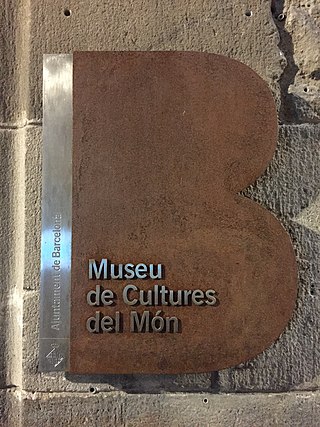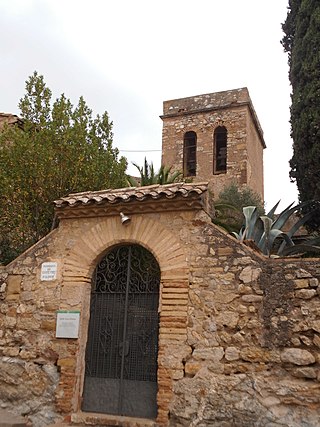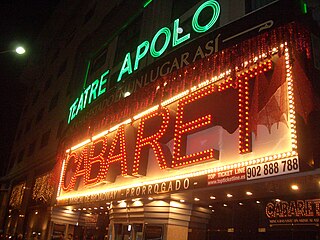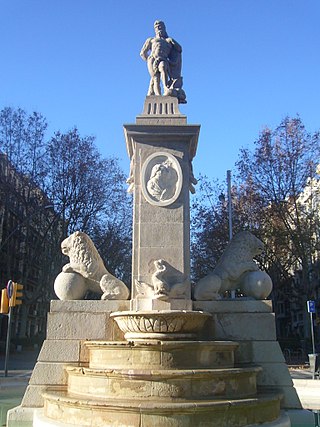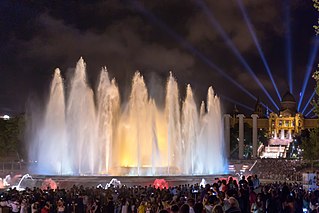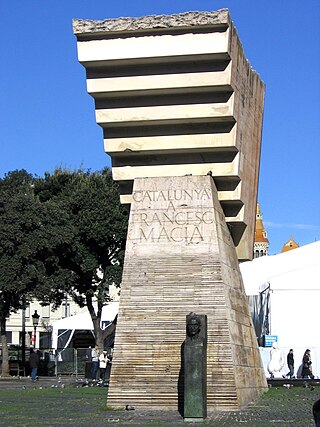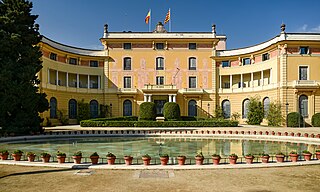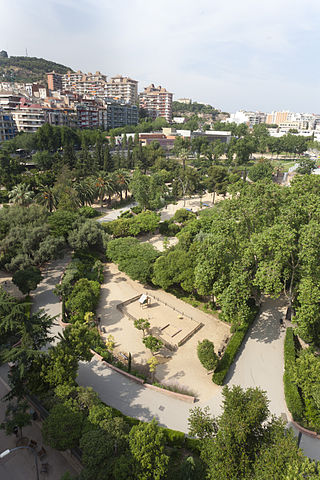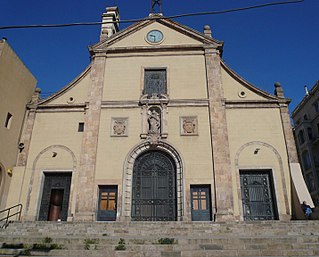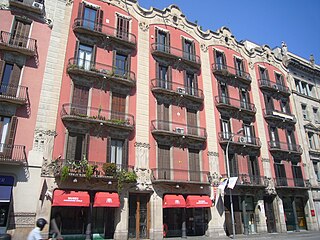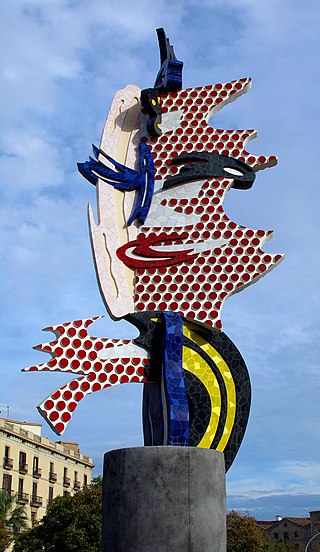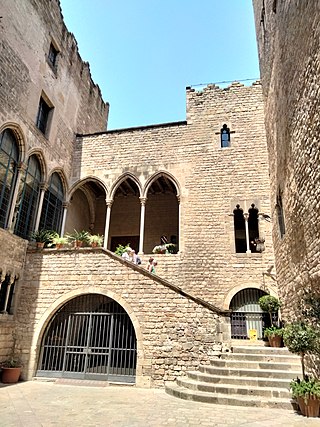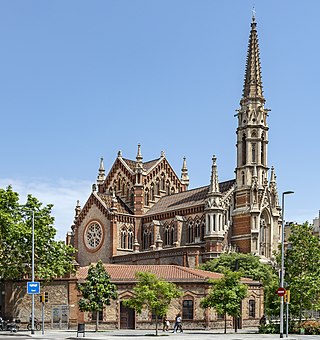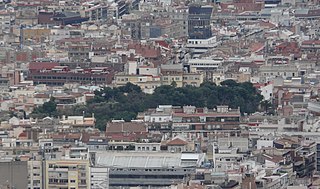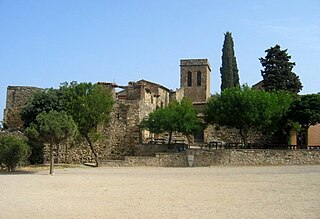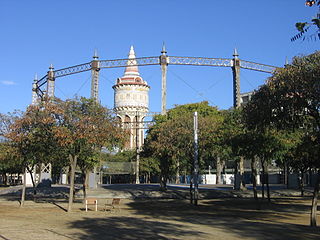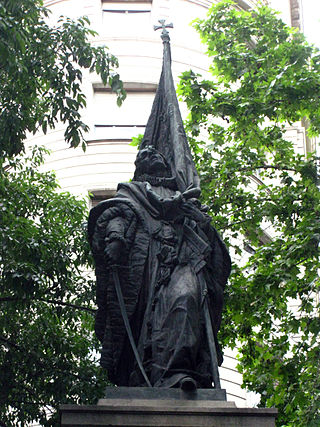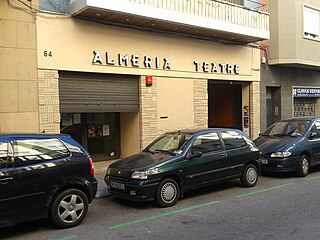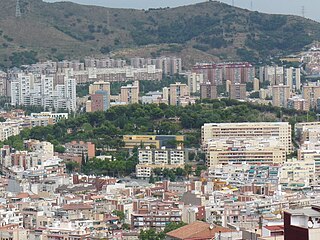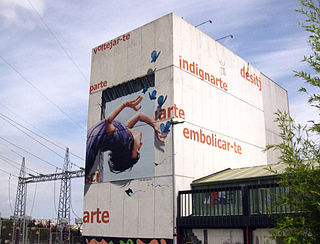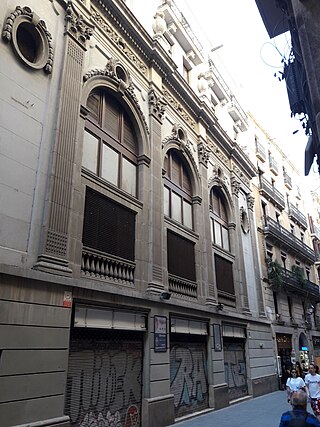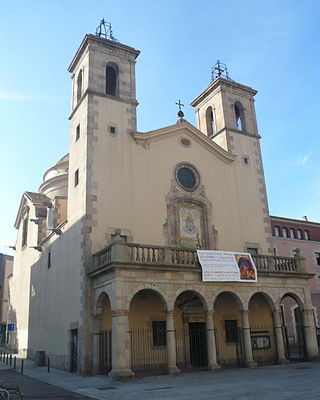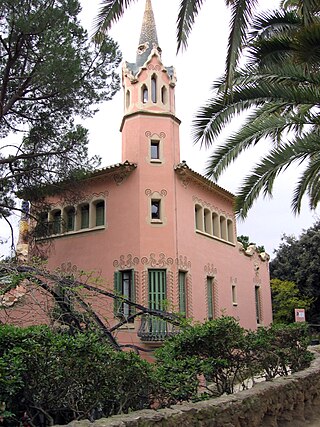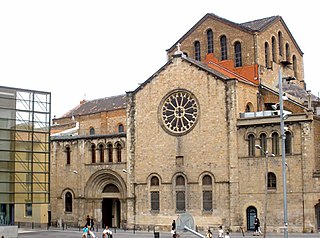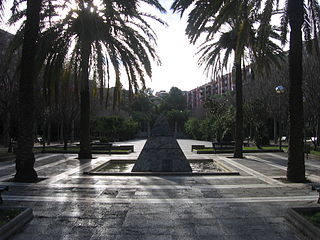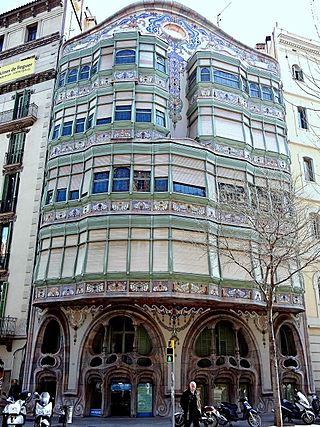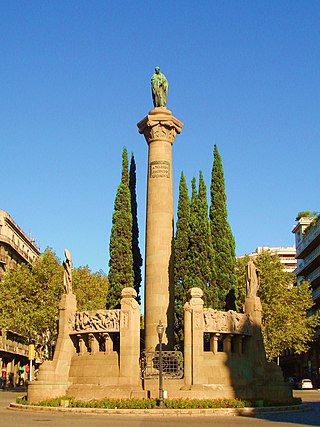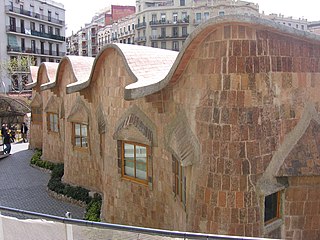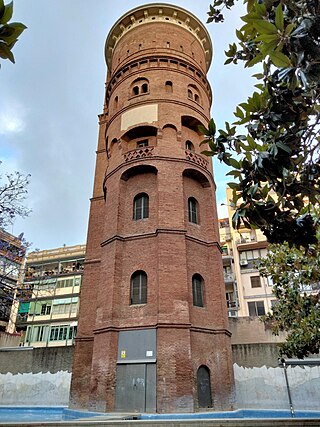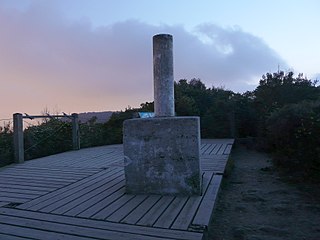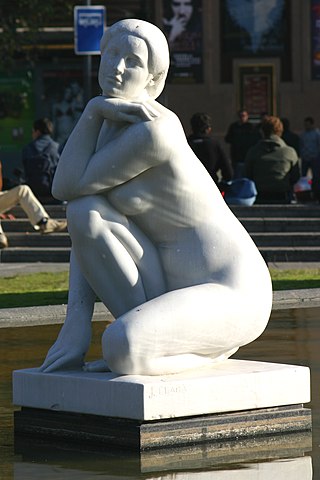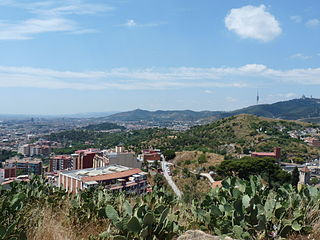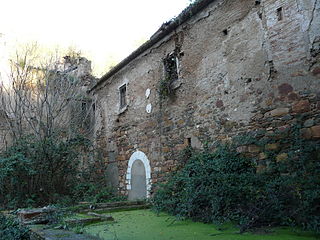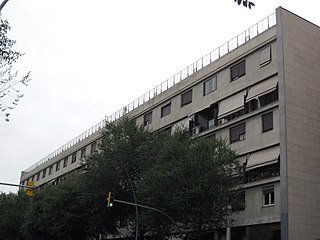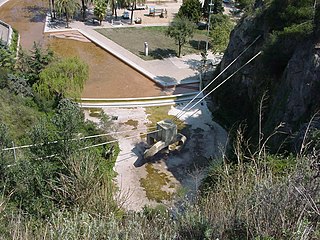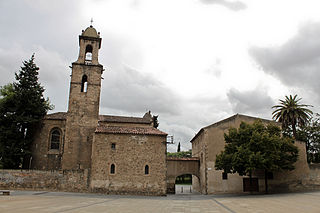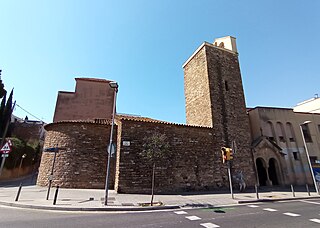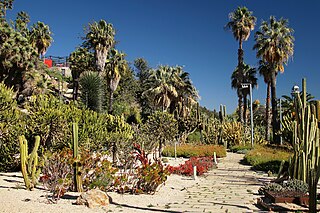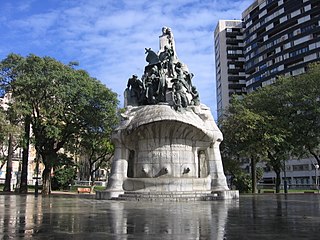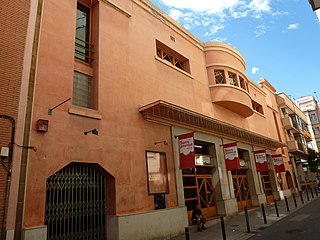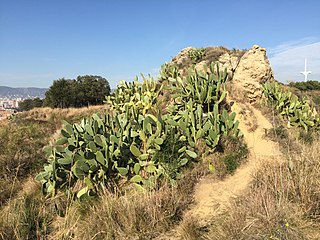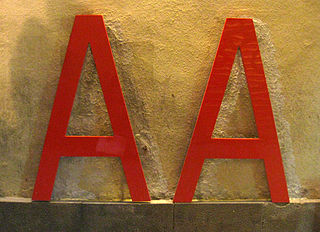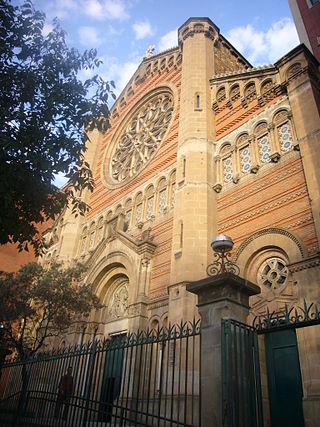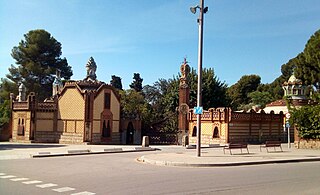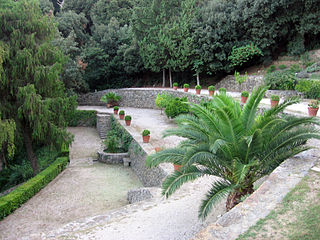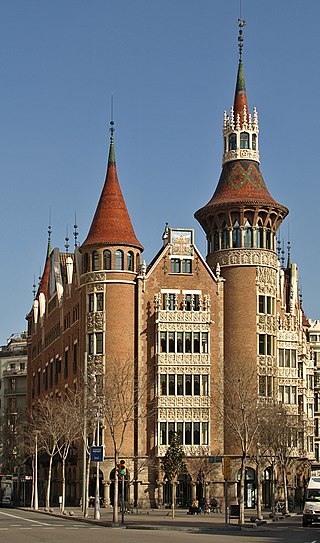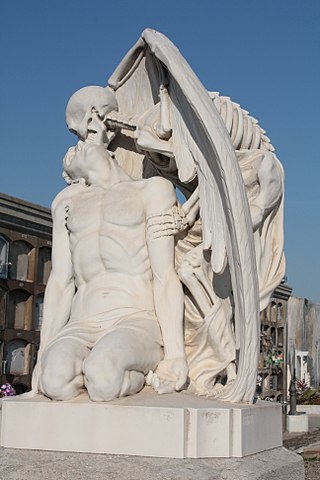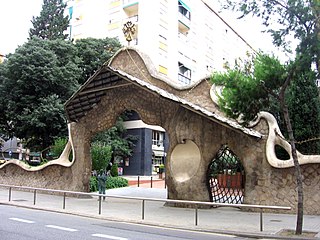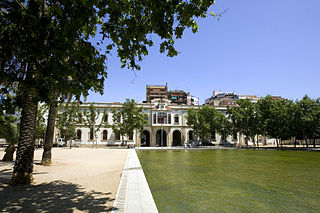100 Sights in Barcelona, Spain (with Map and Images)
Legend
Premium Sights
Book tickets, guided tours and activities in Barcelona.
Guided Free Walking Tours
Book free guided walking tours in Barcelona.
Welcome to your journey through the most beautiful sights in Barcelona, Spain! Whether you want to discover the city's historical treasures or experience its modern highlights, you'll find everything your heart desires here. Be inspired by our selection and plan your unforgettable adventure in Barcelona. Dive into the diversity of this fascinating city and discover everything it has to offer.
Sightseeing Tours in BarcelonaActivities in BarcelonaMercat del Born is a former public market and one of the most important buildings in Barcelona, Catalonia, Spain constructed with iron. Located in the lower and eastern side of the la Ribera neighborhood, it is the largest covered square in all of Europe and marked the start of Modernisme in Catalan architecture.
The Museu Nacional d'Art de Catalunya, abbreviated as MNAC, is a museum of Catalan visual art located in Barcelona, Catalonia, Spain. Situated on Montjuïc hill at the end of Avinguda de la Reina Maria Cristina, near Pl Espanya, the museum is especially notable for its outstanding collection of romanesque church paintings, and for Catalan art and design from the late 19th and early 20th centuries, including modernisme and noucentisme. The museum is housed in the Palau Nacional, a huge, Italian-style building dating to 1929. The Palau Nacional, which has housed the Museu d'Art de Catalunya since 1934, was declared a national museum in 1990 under the Museums Law passed by the Catalan Government. That same year, a thorough renovation process was launched to refurbish the site, based on plans drawn up by the architects Gae Aulenti and Enric Steegmann, who were later joined in the undertaking by Josep Benedito. The Oval Hall was reopened for the 1992 Summer Olympic Games, and the various collections were installed and opened over the period from 1995 to 2004. The museum was officially inaugurated on 16 December 2004. It is one of the largest museums in Spain.
3. Fossar de les Moreres
The Fossar de les Moreres is a memorial square in Barcelona, adjacent to the basilica of Santa Maria del Mar. The plaza was built over a cemetery where defenders of the city were buried following the Siege of Barcelona at the end of the War of the Spanish Succession in 1714. The plaza features a memorial to the fallen Catalans of the war, with a torch of eternal flame and a heroic poem by Frederic Soler, "El Fossar de les Moreres".
4. The Dragon
The Dragon is an iron sculpture located in the Parc de l'Espanya Industrial, in front of the Plaça dels Països Catalans, in the Sants district of Barcelona. The work of the San Sebastian sculptor Andrés Nagel, it was inaugurated on Sant Jordi's Day in 1987. It represents the figure of a dragon coming out of the lake. Made of corten steel, it weighs 150 tons, and is 12 meters high by 38 meters long. What represents the tail of the animal is an 18-meter-long slide, where young and old play. The sculpture has 3 other slides and a maze that joins them.
5. La Rambla
La Rambla is considered the most well known street in central Barcelona. A tree-lined pedestrian street, it stretches for 1.2 kilometres connecting the Plaça de Catalunya in its center with the Christopher Columbus Monument at Port Vell. La Rambla forms the boundary between the neighbourhoods of the Barri Gòtic to the east and the El Raval to the west.
6. Triumphal Arch
The Arc de Triomf is a memorial arch in Barcelona, Catalonia, Spain. It was built by architect Josep Vilaseca i Casanovas as the main access gate for the 1888 Barcelona World Fair. The arch crosses over the wide central promenade of the Passeig de Lluís Companys, leading to the Ciutadella Park that now occupies the site of the world fair. It is located at the northern end of the promenade, facing the Passeig de Sant Joan.
7. Picasso Museum
The Museu Picasso is an art museum in Barcelona, in Catalonia, Spain. It houses an extensive collection of artworks by the twentieth-century Spanish artist Pablo Picasso, with a total of 4251 of his works. It is housed in five adjoining medieval palaces on Montcada Street in the La Ribera neighborhood in the Old City of Barcelona. It opened to the public on 9 March 1963, becoming the first museum dedicated to Picasso's work and the only one created during his lifetime. It has since been declared a museum of national interest by the Government of Catalonia.
8. Castle of the Three Dragons
The Castle of the Three Dragons, is the popular name given to the modernisme building built between 1887 and 1888 as a Café-Restaurant for the 1888 Universal Exposition of Barcelona by Lluís Domènech i Montaner. This name was probably adopted from the 1865 play by Serafí Pitarra.
9. Palau de la Virreina
The Virreina Palace is a building in the city of Barcelona. Situated on the famous La Rambla avenue, today it houses the headquarters of the City Council's Culture Institute, the Institut de Cultura de Barcelona (ICUB) and hosts various temporary art exhibitions and cultural events.
10. Columbus Monument
The Columbus Monument is a 60 m (197 ft) tall monument to Christopher Columbus at the lower end of La Rambla, Barcelona, Catalonia, Spain. It was constructed for the Exposición Universal de Barcelona (1888) in honor of Columbus' first voyage to the Americas. The monument serves as a reminder that Christopher Columbus reported to Queen Isabella I and King Ferdinand V in Barcelona after his first trip to the new continent.
11. Roman Wall
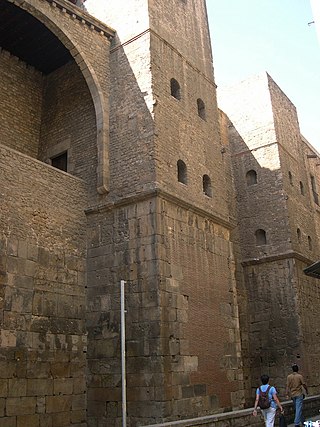
The Roman Wall of Barcelona is a work declared a Cultural Asset of National Interest. From Plaça Nova, it went along Avinguda de la Catedral, Carrer de la Tapineria and Carrer del Sotstinent Navarro, Plaça dels Traginers, and Carrer del Correo Vell, Carrer del Regomir, Carrer d'Avinyó, Carrer dels Banys Nous and Carrer de la Palla.
12. Spotify Camp Nou
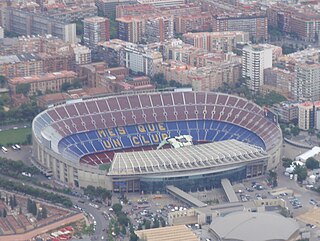
Camp Nou, meaning New Field and often referred to in English as the Nou Camp, is a stadium in Barcelona and the home of La Liga club Barcelona since its opening in 1957. It is currently undergoing renovation, and with a planned increased seating capacity of 105,000 it will be the stadium with the largest capacity in Spain and Europe, and the second largest association football stadium in the world.
13. Park Guell
Park Güell is a privatized park system composed of gardens and architectural elements located on Turó del Carmel, in Barcelona, Catalonia, Spain. Turó del Carmel belongs to the mountain range of Collserola – the Parc del Carmel is located on the northern face. Park Güell is located in La Salut, a neighborhood in the Gràcia district of Barcelona. With urbanization in mind, Eusebi Güell assigned the design of the park to Antoni Gaudí, a renowned architect and the face of Catalan modernism.
14. Palau de la Música Catalana
Palau de la Música Catalana is a concert hall in Barcelona, Catalonia, Spain. Designed in the Catalan modernista style by the architect Lluís Domènech i Montaner, it was built between 1905 and 1908 for Orfeó Català, a choral society founded in 1891 that was a leading force in the Catalan cultural movement that came to be known as the Renaixença. It was inaugurated on 9 February 1908.
15. Barcelona Pavilion
The Barcelona Pavilion, designed by Ludwig Mies van der Rohe and Lilly Reich, was the German Pavilion for the 1929 International Exposition in Barcelona, Spain. This building was used for the official opening of the German section of the exhibition. It is an important building in the history of modern architecture, known for its simple form and its spectacular use of extravagant materials, such as marble, red onyx and travertine. Furnishings specifically designed for the building, including the Barcelona chair, are still in production. It has inspired many important modernist buildings. The original structure was demolished in 1930, and the existing reconstruction was completed in 1986.
16. El Molino
El Molino is a café-concert in Barcelona, one of the most renowned in Europe during much of the twentieth and nineteenth centuries, and has always been considered a space that transgressed the permitted limits, with a great capacity to create its own languages, with a double meaning, with the motive of being able to escape the censorship of each era. With its characteristic red mill blades on the façade, it was the most famous of the theatres on the Paral·lel, an avenue that came to be baptised as "the street of the theatre of Europe", due to the large concentration of scenic spaces it had.
17. Teatre Romea
The Teatre Romea is a performance hall dedicated mainly to theatrical performances, located at Carrer de l'Hospital, 51 in the Raval district of Barcelona and listed as a cultural asset of local interest. In 2015 he received the Creu de Sant Jordi "for the important role that this facility, created in 1863, has played in the culture and society of Barcelona and Catalonia".
18. Casa Vicens
Casa Vicens is a modernist building situated in the Gràcia neighbourhood of Barcelona. It is the work of architect Antoni Gaudí and is considered to be his first major project. It was built between 1883 and 1885, although Gaudí drew up the initial plans between 1878 and 1880. The work belongs to the orientalist style, similar to Neo-Mudéjar architecture, although interpreted in Gaudí’s own personal way, with a uniqueness that only he knew how to add to his projects. In this work, and for the first time, Gaudí outlined some of his constructive resources that would become regular features throughout the emergence of Modernisme. The work was widely discussed when it was built and caused a great sensation among the general public at the time. When the building was constructed, Gràcia was still an independent urban nucleus of Barcelona; it had its own council and was classified as a town, though nowadays it is a district of the city.
19. Centre Parroquial de Sant Vicenç de Sarrià
The Sant Vicenç de Sarrià Parish Centre is an entity dependent on the parish of Sant Vicenç de Sarrià, in Barcelona. The center was established in 1943 as a continuation of the Sant Josep Institute, which in 1907 was founded in this parish from the Josefina Academy, created in 1896 to offer training and recreation for lay people. The centre also has sections dedicated to football, recreation, catechesis and cooperation, and hosts theatre, music, chess and sewing groups.
20. Barcelona Museum of Contemporary Art
The Barcelona Museum of Contemporary Art is a contemporary art museum situated in the Plaça dels Àngels, in El Raval neighborhood, Ciutat Vella district, in Barcelona, Catalonia, Spain. The museum opened to the public on 28 November 1995.
Wikipedia: Barcelona Museum of Contemporary Art (EN), Website
21. Museu Egipci
The Egyptian Museum of Barcelona, located at Carrer de València, 284, belongs to the Clos Archaeological Foundation, a non-profit organisation founded in 1992 by the businessman Jordi Clos i Llombart. Its objective is the promotion and dissemination of art in general and archaeology, especially of ancient Egypt.
22. el Tibidabo
Tibidabo is a hill overlooking Barcelona, Catalonia, Spain. At 512 metres (1,680 ft), it is the tallest hill in the Serra de Collserola. Rising sharply to the north-west, it has views over the city and the surrounding coastline.
23. Museu d'Història de la Ciutat
The Museum of the History of Barcelona is a history museum that conserves, researches, communicates and exhibits the historical heritage of the city of Barcelona, from its origins in Roman times until the present day. The museum's headquarters are located on Plaça del Rei, in the Barcelona Gothic Quarter. It also manages several historic sites all around the city, most of them archaeological sites displaying remains of the ancient Roman city, called Barcino in Latin. Some others date to medieval times, including the Jewish quarter and the medieval royal palace called the Palau Reial Major. The rest are contemporary, among them old industrial buildings and sites related to Antoni Gaudí and the Spanish Civil War.
24. Teatre Tívoli
The Tivoli Theatre is a building located at Carrer de Casp, 6-20 in Barcelona, listed as a cultural asset of local interest. It is one of the largest theatres in the city and has hosted performances of opera and zarzuela, as well as musical works and Catalan theatre, even seeing their world premiere or premiere in the city.
25. Pati Manning
The Casa de la Caritat is a group of buildings in the Raval district of Barcelona, listed as a Cultural Asset of Local Interest. It currently houses a cultural complex made up of several institutions, such as the Centre for Contemporary Culture of Barcelona, in the Pati de les Dones, and the Centre for Cultural Studies and Resources (CERC) of the Barcelona Provincial Council, in the Pati Manning, and the Blanquerna Faculty of Communication and International Relations of the Ramon Llull University. The House itself has 2 Corpus Christi Giants exhibited for La Mercè in the Manning Courtyard and in the Casa dels Entremesos and those of the Carnival permanently exhibited in the Palau de la Virreina
26. Poble Espanyol
The Poble Espanyol is an open-air architectural museum in Barcelona, Catalonia, Spain, approximately 400 metres away from the Fountains of Montjuïc. Built for the 1929 Barcelona International Exposition, the museum consists of 117 full-scale buildings replicated from different places in the Iberian Peninsula, joined forming a small town recreating urban atmospheres of disparate places in Spain. It also contains a theater, restaurants, artisan workshops and a museum of contemporary art.
27. Església de Sant Agustí Nou
The convent of Sant Agustí Nou was a group of buildings belonging to the Augustinian order, of which some remains still remain, such as the old library, now a hotel, and the church, listed as a cultural asset of local interest.
28. Baluard de Migdia i Muralla de Mar
The bastion of Migdia is one of the eleven bastions that the medieval and modern walls of Barcelona had until the whole of the city walls was demolished in the nineteenth century. The Baluard de Migdia was the scene of several episodes in the history of Barcelona, including the violent battles that took place on the eleventh of September 1714. The bastion was rediscovered in 2007, near Estació de França and Barceloneta Station, and its current remains are part of the architectural and historical heritage of the city of Barcelona.
29. Claustre de l'església de la Concepció
Santa Maria de Jonqueres was a monastery of nuns in the city of Barcelona that was on Jonqueres Street from the thirteenth to the nineteenth century, when the church and the cloister were transferred stone to stone in Aragon Street and today in Day is part of the Parish Church of the Conception in the Eixample district.
30. Jardins de Winston Churchill
The Winston Churchill Gardens are an urban park located on the lower corner of the intersection of Via Augusta and Ronda del General Mitre, in the Les Tres Torres district of Barcelona, very close to the station of the same name of the Ferrocarrils de la Generalitat (FGC). They are dedicated to Sir Winston Churchill (1874-1965), British politician and writer, Prime Minister of the United Kingdom during World War II and the post-war years, as well as Nobel Prize in Literature (1953).
31. Temple Expiatori del Sagrat Cor
The Temple Expiatori del Sagrat Cor is a Roman Catholic church and minor basilica located on the summit of Mount Tibidabo in Barcelona, Catalonia. The building is the work of the Catalan architect Enric Sagnier and was completed by his son Josep Maria Sagnier i Vidal. The construction of the church, dedicated to the Sacred Heart of Jesus, lasted from 1902 to 1961.
32. Palau Macaya
The Palau Macaya is a modernist building at Passeig de Sant Joan, 108 in Barcelona, declared a national monument by the Ministry of Education and Science on January 9, 1976, along with other works by Puig i Cadafalch. In 1979 it became the first headquarters of the cultural centre of la Caixa, currently CaixaForum Macaya.
33. Església de Sant Sever
The church of Sant Sever is located on the street of the same name in the Gothic Quarter of Barcelona, very close to the Cathedral, and is listed as a Cultural Asset of Local Interest. Unlike most of Barcelona's churches, it was not destroyed during the Civil War, which is why the interior, an example of Catalan Baroque, has been so well preserved. Since 2002, it has been part of the chapter of the Cathedral of Barcelona.
34. Museu de Cultures del Món
The Museum of World Cultures was a museum specialising in the history of various cultures from around the world that occupies the Palau Nadal, former headquarters of the Barbier-Mueller Museum of Pre-Columbian Art in Barcelona, as well as the Palau del Marquès de Llo, former headquarters of the Design Museum, at Carrer de Montcada, 12 and 14 in Barcelona. The cost of the adaptation works was 4,195,000 euros. and the project was commissioned to the architects Tomàs Morató and Jaume Arderiu.
35. Caçador de Lleons
The Lion Hunter is one of the sculptures that are part of the Parc de la Ciutadella in Barcelona, where it was placed on September 21, 1883. This piece, the work of the sculptor Agapit Vallmitjana i Abarca, was commissioned directly by the Barcelona City Council, in a contract signed on April 30 of that same year, within the context of the upcoming Universal Exhibition that would be held in the city in 1888.
36. Plaça de la Vila de Gràcia
The Plaça de la Vila de Gràcia is a square in the Gràcia district of Barcelona and the administrative centre of the district of Gràcia. It is framed by the streets Matilde, Mariana Pineda, Penedès, Diluvi, Francisco Giner, Mozart, Goya and Sant Domènec. It is one of the busiest social centres in the Gràcia neighbourhood. It regained its popular name in 2009 after a public consultation, although it is also popularly known as Plaça del Campanar or Plaça del Rellotge. It is a space included in the Inventory of the Architectural Heritage of Catalonia.
37. Centre Cívic Pati Llimona
The Palau Marc or Gualbes is a building in the Gothic Quarter of Barcelona listed as a cultural asset of local interest. Since 1991, it has housed the facilities of the Pati Llimona Civic Centre, which has an exhibition hall, an archaeological space and several classrooms and rooms for workshops and conferences.
38. Santa Creu d'Olorda
The Santa Creu d'Olorda is a hermitage and also receives this name from the enclave where it is built, which administratively belongs to the district of Sarrià-Sant Gervasi in the municipality of Barcelona, but slightly separated from the rest of the municipality. The site is located in the heart of the Collserola mountain range surrounded by some of its peaks such as Puig d'Olorda, Turó Rodó, Turó del Xai. In the enclave there is also the Castle of Olorda and the Pedrera dels Ocells.
39. Poliorama
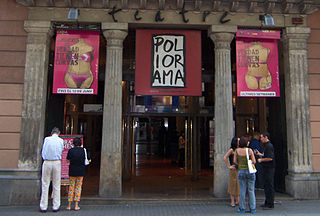
The Poliorama Theater is a theater, former cinema, located on the ground floor of the building of the Royal Academy of Sciences and Arts of Barcelona, at Rambla, 115. Opened in 1899 as a cinema, it later alternated its use with theatrical performances. It has been operating since 1976 as a theatre. Between 1937 and 1939 it was called the Teatre Català de la Comèdia.
40. Parròquia de Sant Andreu de Palomar
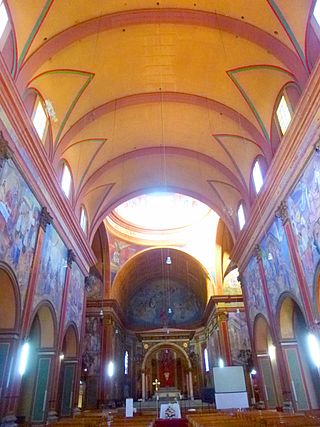
The church of Sant Andreu de Palomar is located in the Plaça d'Orfila in the district of the same name in Barcelona, and is listed as an asset with elements of interest. In 1991 he received the Cross of Saint George, together with the Casa Asil de Sant Andreu, created in 1866 and linked to the parish.
41. Teatre Apolo
The Apolo Theater is a theatrical space located at no. 59 Avinguda del Paral·lel in Barcelona, in the Poble-sec neighbourhood. The old Apolo was built in 1901 and, uninterruptedly until today, except during the COVID-19 pandemic episode in Catalonia between 2020 and 2021, it has offered variety, music and theater shows.
42. Font d'Hèrcules
The Fountain of Hercules, also known as the Gaudí Fountain, is located in the gardens of the Royal Palace of Pedralbes in Barcelona. It was built in 1884 according to a design by the architect Antoni Gaudí. It is listed as a Cultural Asset of Local Interest (BCIL).
43. Magic Fountain of Montjuïc
The Magic Fountain of Montjuïc is a fountain located at the head of Avinguda Maria Cristina in the Montjuïc neighborhood of Barcelona, Catalonia, Spain. The fountain is situated below the Palau Nacional on the Montjuïc mountain and near the Plaça d'Espanya and Poble Espanyol de Barcelona. The fountain, like most of the surrounding developments, was constructed for the 1929 Barcelona International Exposition.
44. Joan Miró pavement mosaic
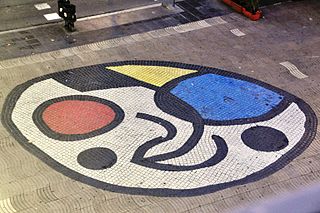
El Mosaic del Pla de l'Os també conegut com a Paviment Miró és una obra de 1976 feta per Joan Miró que es troba al Pla de la Boqueria, a la Rambla de Barcelona, camí natural de qui va o ve del mar a la ciutat. L'obra fou inaugurada el 30 de desembre del 1976, i està inclosa en el catàleg Art Públic de Barcelona. El mosaic va ser executat per Joan Gardy-Artigas, amb la col·laboració dels tallers Escofet, especialitzats en peces de terratzo.
45. Monument to Francesc Macià
The Monument to Francesc Macià is a sculpture located at the southern end of Plaça de Catalunya in Barcelona, in front of La Rambla, the work of Josep Maria Subirachs and inaugurated on 25 December 1991.
46. Palau Reial de Pedralbes
The Royal Palace of Pedralbes is a building placed in the middle of an ample garden in the district of Les Corts, in Barcelona. From 1919 until 1931 and since 1975 it has been the official residence for the Spanish royal family when they visit the city, although they currently prefer the Palace of Albéniz. It also houses the Ceramic Museum, the Textile and Clothing Museum and the Decorative Arts Museum, both part of the Disseny Hub Barcelona and is the permanent seat of the Union for the Mediterranean (UfM).
47. Parc de les Aigües
The Parc de les Aigües is located in the Baix Guinardó neighbourhood of Barcelona, surrounded by the Ronda del Guinardó, Carrer d'Abd El-Kader, Carrer de les Camèlies and the Hiroshima Gardens, and has an area of 2 hectares.
48. Església de la Mare de Déu de Gràcia i de Sant Josep
The Church of the Virgin of Grace and Saint Joseph, popularly known as the Josepets de Gràcia, is the church of the former convent of the Discalced Carmelites of Santa Maria de Gràcia, located at the top of the modern Plaça de Lesseps in the district of Gràcia, in Barcelona, where it is the oldest building in the neighborhood. It is a work protected as a Cultural Asset of Local Interest.
49. Museu del Modernisme Català
The Museum of Catalan Modernism (MMCAT) – also known as the Museum of Modernism of Barcelona (MMBCN) – is a museum inaugurated in 2010 and dedicated entirely to Catalan modernism. It occupies the thousand square meters divided into two floors of a modernist building, from 1902 and 1904, by the architect Enric Sagnier, at Carrer de Balmes 48, in Barcelona, between the Provincial Council and the Consell de Cent. It shows 350 works, including paintings, sculptures, furniture and stained glass, by 42 artists representative of this artistic movement. The vast majority of the works come from the private collection of the Pinós-Guirao family, and many are unpublished. You can find pieces by Antoni Gaudí, Joaquim Mir, Hermen Anglada Camarasa, Ramon Casas and Santiago Rusiñol. It is the first Museum of Catalan Modernism open to the world.
50. Barcelona's Head
El Cap de Barcelona (1991–1992) is a surrealist sculpture created by American Pop artist Roy Lichtenstein for the 1992 Summer Olympics in Barcelona, Catalonia, Spain. Its English title is The Head of Barcelona.
51. Palau Requesens
The Requesens Palace, also known as the Countess of Palamós, is a building in the Gothic Quarter of Barcelona declared a cultural asset of national interest. It is currently the headquarters of the Royal Academy of Letters and also houses the Gallery of Illustrious Catalans.
52. Teatre Nacional de Catalunya
Teatre Nacional de Catalunya is a public theatre located in Barcelona, Catalonia, Spain. It was created by the Culture Department of the Catalan Government to normalize and enhance the theatre and dance in Catalan language and their creators.
53. Sant Francesc de Sales
The church and convent of Les Saleses is a complex formed by the church and the old convent of the Saleses nuns of the Order of the Visitation, located on the Paseo de San Juan in Barcelona, between the streets of Valencia and Aragón. It was designed by Joan Martorell i Montells. Work on the convent began in 1877 and the church was built between 1882 and 1885, corresponding to the current parish of Sant Francesc de Sales. The old convent was converted in 1943 into a school of the Marist Brothers. It is a work protected as a cultural asset of local interest.
54. Turó de Monterols
The Turó de Monterols, also called Turó d'en Gil, is considered one of the seven hills of Barcelona, a figure taken in imitation of the seven hills of Rome. The park occupies an area of 1.94 ha and reaches an altitude of 127 meters above sea level.
55. Castell d'Olorda
The castle of Olorda, located in the Collserola mountain range near the Puig d'Olorda and the Pedrera dels Ocells, belongs to the municipality of Barcelona, is a disappeared castle of uncertain location. Some sources place it at the very top of Puig d'Olorda. On the other hand, others identify it as the house located next to the hermitage of Santa Creu d'Olorda.
56. CaixaForum Barcelona
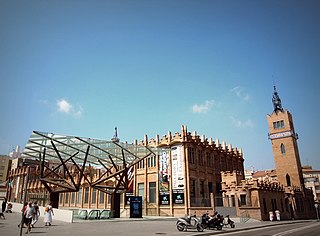
CaixaForum Barcelona is a cultural center in Barcelona, Catalonia, Spain. Located in the Montjuïc area in a former Modernist textile factory designed by Josep Puig i Cadafalch, it is owned by the not-for-profit banking foundation "la Caixa". After a restoration of the building, the art center opened its doors in 2002 and since then it hosts temporary art exhibitions and cultural events.
57. Parc de la Barceloneta
The Parc de la Barceloneta is located in the neighbourhood of the same name in Barcelona, bordered by the streets of Doctor Aiguader and Gas, and the promenades of Barceloneta and Salvat Papasseit. From the old Catalana de Gas factory, the metal structure of the gasometer, designed by the engineer Claudi Gil i Serra in 1868, as well as the water tower and the office building, listed as a cultural asset of local interest, remain.
58. Refugi 307
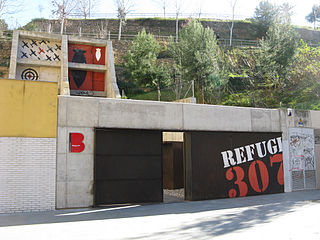
Shelter 307 is one of the air-raid shelters for the civilian population built during the Spanish Civil War in the city of Barcelona, listed as an asset with elements of interest. It was excavated thanks to the work of many neighbors in the Poble Sec neighborhood, and is currently open to the public as part of the Barcelona History Museum.
59. Monument to Rafael Casanova
The Monument to Rafael Casanova is a sculpture located at the intersection of Ronda de Sant Pere and Carrer d'Alí Bei in Barcelona, listed as a cultural asset of local interest. A work by the sculptor Rossend Nobas (1888), it is a tribute to Rafael Casanova i Comes, the last chief councillor of Barcelona.
60. Almeria Teatre
Golem's, historically Almeria Teatre, is a theater room in Barcelona, located at 64 Sant Lluís Street, in the Gràcia district. It is a multipurpose space that has a stage, plate and amphitheater with a capacity of 183 spectators. The room was reopened on December 18, 2009 and recovered a disused cultural space, the theater of the old House of Almería, founded in the district of Gràcia in 1960 and, in the early 1970's, became a of the Bingos of Barcelona.
61. Elogi de l'aigua
In Praise of Water is a 1987 sculpture by Eduardo Chillida located in the Parc de la Creueta del Coll in Barcelona. It is a solid piece of reinforced concrete from which four arms come out that are screwed suspended by four steel cables over a pond. It weighs 54 tons and measures 12 meters high by 7.2 meters long and 6.5 meters wide. The work is located in an old quarry, in one of the areas urbanized on the occasion of the 1992 Summer Olympics, whose walls delimit and house the monument. This sculpture was installed the same year that the artist received the Prince of Asturias Award for the Arts.
62. Turó de la Peira
Turó de la Peira or Montadell is a hill in Barcelona, in the district of Nou Barris; between the old municipalities of Sant Andreu de Palomar and Sant Joan d'Horta and between the old streams of Horta and Parellada. On its slopes rise the neighbourhoods of Can Peguera and Turó de la Peira. The name comes from Ca la Peira, a farmhouse that existed between the Horta stream and the Can Mariner stream. In 1936 the Turó de la Peira park was inaugurated, and in 1947 the surrounding blocks of houses began to be built. At the top of the hill there is a large iron cross and a viewpoint from which there is a panoramic view of Barcelona.
63. Ateneu Popular de Nou Barris
The Ateneu Popular de Nou Barris is a cultural center born in 1977 in Barcelona in the neighborhood of La Trinitat Nova, in the district of Nou Barris, in a building that was an old asphalt plant. Since its inception, it has had a high dedication to the world of circus, including the Winter Circus, which has been held since 1997, the Rogelio Rivel circus school, in operation since 1999, and the children's circus school.
64. Club Capitol
The Club Capitol was a theater located on La Rambla and Carrer de Santa Anna in Barcelona. Founded in 1926 as a cinema, in 1989 it was renovated and converted into a theater in 1997. It had two screens, Club Capitol 1 with 523 seats, and Club Capitol 2 with 274. The last performance was held on March 12, 2020.
65. Sant Pere Nolasc
The Church of Sant Pere Nolasc, formerly of Sant Sever and Sant Carles Borromeu, is a building located in Plaça de Castella in the Raval district of Barcelona, listed as a cultural asset of local interest. It is the only part that remains of the old convent of the Pauls, called Casa de Sant Sever.
66. A Galceran Marquet
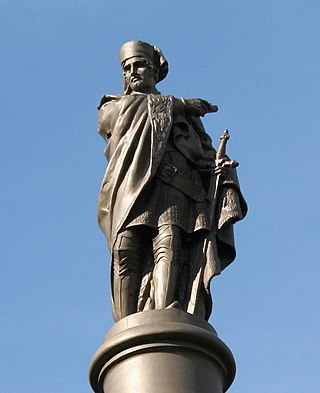
A Galceran Marquet is a monument in homage to the Catalan vice-admiral Galceran Marquet, located in the Plaça del Duc de Medinaceli in Barcelona. Created in 1851, it was the work of the architect Francesc Daniel Molina and the sculptor Damià Campeny, assisted in the decoration of the base by Josep Anicet Santigosa. It is listed as a Cultural Asset of Local Interest.
67. Jardins de Portola
The Portolà Gardens, with an area of 626 m², are located in the streets of the same name and Claudi Sabadell in the Putxet district of Barcelona. Inaugurated in 2005, they belong to the modernist tower Vil·la Matilde, built around 1910 and listed as a cultural asset of local interest.
68. Barcelona Shoe Museum
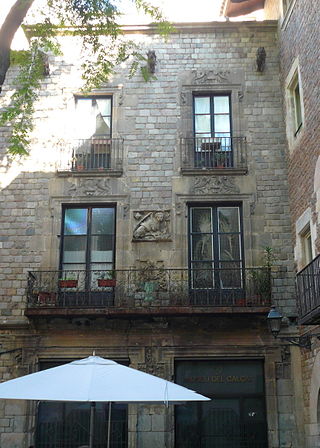
The Barcelona Footwear Museum is a small museum located in the Gothic Quarter of Barcelona, in Plaça de Sant Felip Neri that was inaugurated in 1970 and closed at the end of 2015. He stayed in the House of the Shoemakers' Guild, headquarters of the brotherhood of master shoemakers. The building is a work protected as a cultural asset of local interest.
69. Casa Museu Gaudí
The Gaudí House Museum, located within the Park Güell in Barcelona, is a historic home museum that houses a collection of furniture and objects designed by the Spanish architect Antoni Gaudí. It was the residence of Gaudí for almost 20 years, from 1906 until the end of 1925. On 28 September 1963 it opened as a historic home museum.
70. Park of the Labyrinth of Horta
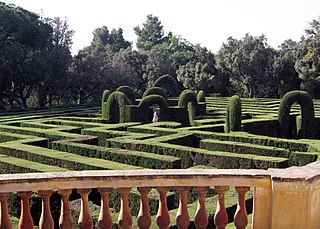
The Parc del Laberint d'Horta is a historical garden in the Horta-Guinardó district in Barcelona and the oldest of its kind in the city. Located on the former estate of the Desvalls family, next to the Collserola ridge, the park comprises an 18th-century neoclassical garden and a 19th-century romantic garden. On the lower terrace is the hedge maze that gives the park its name.
71. Santa Maria de Montalegre
Santa Maria de Montalegre is a church located on Carrer de Valldonzella in the Raval district of Barcelona, which is part of the Casa de la Caritat complex, listed as a cultural asset of local interest.
72. Parc de Can Sabaté
The Can Sabaté park is located in the Marina de Port, in the Sants-Montjuïc district of Barcelona. It was built in 1984 with a project by Neus Solé, Imma Jansana and Daniel Navas, who had the advice of Nicolau Maria Rubió i Tudurí, former director of Parks and Gardens of Barcelona between 1917 and 1937, author of Montjuïc Park together with Jean-Claude Nicolas Forestier in 1929.
73. Mirador de Torre Baró
The Torre del Baró or Castell de Torre Baró is a building protected as a cultural asset of local interest that stands on one of the easternmost hills of the Collserola ridge that overlooks the Pla de Barcelona. It has become the most representative image of the Torre Baró neighbourhood.
74. Casa Comalat
Casa Comalat is a modernist building located on Avenida Diagonal and Carrer de Còrsega in Barcelona's Eixample, listed as a Cultural Asset of Local Interest. It is the most important and personal work of the architect Salvador Valeri i Pupurull, who used characteristic cartilaginous and voluminous shapes inspired by Gaudí and with a Rococo-inspired decoration.
75. Monument a Mossèn Jacint Verdaguer
The monument to Mossèn Jacint Verdaguer, popularly known as El cuervo or La palmatòria, is a monument in the Noucentista style designed by the architect Josep Maria Pericas and crowned with a bronze statue by the sculptor Joan Borrell i Nicolau that represents the poet Jacint Verdaguer i Santaló. Llucià Oslé and Miquel Oslé are the authors of the reliefs that make up the frieze that surrounds the monument, alluding to several poems by Verdaguer. The monument is located in Plaça de Mossèn Jacint Verdaguer, at the intersection of Passeig de Sant Joan and Avinguda Diagonal.
76. Sagrada Família Schools
The Sagrada Família Schools building was constructed in 1909 by the modern Spanish architect Antoni Gaudí near the site of the Basílica de la Sagrada Família. It was a small school building for the children of the workers building the Sagrada Família, although other children of the neighborhood attended, especially from the underprivileged classes. The teaching was in the charge of Magin Espina Pujol, math teacher and friend of Gaudí, whose photo teaching classes are in the current school.
77. Torre de les Aigües de l'Eixample
The Torre de les Aigües is a construction listed as a Cultural Asset of Local Interest, located in the courtyard of the block of houses bounded by the streets of Roger de Llúria, Consell de Cent, Bruc and Diputació. Access is through an open passage at Carrer de Roger de Llúria, 56.
78. Turó del Maltall de Magarola
The Turó de la Magarola or Turó del Maltall de Magarola is a 430-metre hill at the intersection of the municipalities of Barcelona (Barcelonès) and Cerdanyola del Vallès and Sant Cugat del Vallès, in the Collserola mountain range. At the top there is a geodesic vertex.
79. The Goddess
The Goddess, or The Enigma, is a white marble sculpture by the sculptor Josep Clarà i Ayats, located in Plaça Catalunya in Barcelona, although the original is in the lobby of the Casa de la Ciutat, and another copy is exhibited in the Museu Nacional d'Art de Catalunya. It is one of the best known works of the shield, and one of the two that the City Council commissioned him as part of the project to beautify squares, gardens and streets for the International Exhibition of 1929.
80. Turó del Carmel
The Turó del Carmel or Turó d'en Móra is a mountain of 289 meters in the municipality of Barcelona, in the region of Barcelonès. It was formerly known as Turó d'en Móra, referring to Can Móra, which was located where the Coll neighbourhood is today. In 1875, the first turrets began to be built on the hill, and over time they gave rise to the Carmel district. Currently, only the highest area of the hill is not urbanized, and it is where Park Güell, Carmel Park and the Juan Ponce Gardens are located.
81. Parc del Turó del Putxet
The Turó del Putxet Gardens are located on the hill of the same name, in the neighbourhood of El Putxet i el Farró in Barcelona. It is considered one of the seven hills of Barcelona, a figure taken in imitation of the seven hills of Rome.
82. Torre de Santa Margarida
Torre de Santa Margarida o Monestir de Valldonzella és un antic monestir, i posteriorment masia, ara en ruïnes, que és un monument protegit com a bé cultural d'interès local del municipi de Barcelona. És el lloc on va morir l'últim rei de la dinastia catalana, Martí l'Humà.
83. Pis-Museu Casa Bloc
Casa Bloc is a residential building built between 1932 and 1936 located at 101 Passeig de Torras i Bages, in the Sant Andreu district of the city of Barcelona. Its architects were Josep Lluís Sert (1902–1983), Josep Torres Clavé (1906–1939) and Joan Baptista Subirana (1904–1978), all members of GATCPAC (Catalan Group of Architects and Technicians for the Progress of Contemporary Architecture). Catalan architects of the Second Republic, brought together by the GATCPAC, proposed a new way of living that was just, accommodated co-existence and defended the collective identity. The creation of Casa Bloc was one of the first steps towards dignifying workers' living conditions. As a result of the Spanish Civil War, the project was cut short. In 2012, after a careful restoration by the Institut Català del Sòl and Institut de Cultura of Barcelona through the Disseny Hub Barcelona, the doors to apartment number 1/11 are open and furnished just as its creators had originally wanted.
84. Parc de la Creueta del Coll
Parc de la Creueta del Coll is a park in the Gràcia and Horta districts of Barcelona, Catalonia, Spain. The park was created from an abandoned quarry as part of the nou urbanisme developments during the 1992 Summer Olympics by architects Martorell, Bohigas and Mackay.
85. Sant Martí de Provençals
Sant Martí de Provençals or Sant Martí Vell is a church located in the Plaça d'Ignasi Juliol, where Carrer del Fondal de Sant Martí meets Carrer de la Selva del Camp in the Sant Martí de Provençals neighbourhood of Barcelona, catalogued as a cultural asset of local interest.
86. Mare de Déu del Coll
The Virgin of the Coll, or of Font-rúbia, is a church in the Coll neighborhood —to which it gives its name—, in the district of Gràcia of Barcelona. It is a Romanesque church of the eleventh century, of which the central body and the bell tower are preserved, being the other current elements of the twentieth century church.
87. Jardins de Mossèn Costa i Llobera
Mossèn Costa i Llobera Gardens is a botanical garden in the center of Barcelona, Catalonia, Spain. It is situated at the foot of Montjuïc facing the sea. The park owes its name to the renowned Mallorcan poet Miquel Costa i Llobera.
88. Monument a Bartomeu Robert
The Monument to Doctor Robert is a sculptural ensemble today inside the Plaça de Tetuan in Barcelona, in the Eixample district. It is dedicated to Bartomeu Robert, a Catalanist doctor and politician, mayor of Barcelona between March and October 1899. The monument is considered a cultural asset of local interest (BCIL) in the Inventory of Catalan Cultural Heritage with the code 08019/1598.
89. Parc de l'Estació del Nord
The Parc de l'Estació del Nord is located in the Fort Pienc neighborhood in the Eixample district of Barcelona. It was created in 1988 with a project by Andreu Arriola, Carme Fiol and Enric Pericas. In 1999 it was expanded by Patrizia Falcone.
90. Teatre Joventut
The Teatre Joventut is the municipal theatre on Carrer Joventut in L'Hospitalet de Llobregat, and to get there you can use the metro, line 5 Collblanc or line 1 Torrassa, or take the section to the Can Rigalt stop.
91. Castell de Port
Port Castle is a ruined castle located southwest of Montjuïc Mountain. It was a very important defensive structure in Barcelona from the eleventh century to the second half of the fifteenth century. It is one of the most unknown structures in the city despite its strategic and control importance. Its strategic value was associated with its role as a watchtower within the road network that during this period linked the city of Barcelona with the neighbouring towns, especially those of the Llobregat Delta.
92. Lletres gimnastes
Lletres Gimnastes is a work of visual art created by the Catalan poet and visual artist Joan Brossa i Cuervo in 1997. It was created for the El Ingenio store, at that time the oldest in its field in Barcelona, as a corporeal poem and to pay homage and remember Mr. Cardona, founder of the establishment.
93. Church of the Immaculate Heart of Mary
The Church of the Immaculate Heart of Mary is a sanctuary and temple built by the Claretians between 1904 and 1913 in the current neighborhood of Camp d'en Grassot and Gràcia Nova in Barcelona. It is a work included in the Inventory of the Architectural Heritage of Catalonia.
Wikipedia: Església de l'Immaculat Cor de Maria (Barcelona) (CA)
94. Güell Pavilions
The so-called Pavellons Güell, or Güell Pavilions, is a complex of buildings in the neighborhood of Pedralbes, Barcelona, by the Catalan Modernist architect Antoni Gaudí, built between 1884 and 1887.
95. Jardins del Vivers de Can Borni
The Viver de Can Borni, or Jardins del Viver de Can Borni, is a public garden in Barcelona located at the foot of Tibidabo, at the top of the Font del Bacallà stream, in the Sant Genís dels Agudells neighbourhood.
96. Far del Llobregat
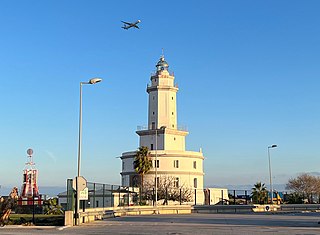
The Llobregat Lighthouse has been located in the municipality of Barcelona since 1920 where it was in the municipality of L'Hospitalet de Llobregat. It is a work protected as a cultural asset of local interest. The lighthouse is located on the left bank of the Llobregat River, north of its former mouth, currently within the Port of Barcelona.
97. Casa de les Punxes
The Casa de les Punxes or Casa Terradas is a building designed by the Modernista architect Josep Puig i Cadafalch. Located in the intersection between the streets of Rosselló, Bruc and the Avinguda Diagonal in the Barcelona Eixample area.
98. The Kiss of Death
The Kiss of Death, in Catalan: "El petó de la mort", in Spanish: "El beso de la muerte", is a marble sculpture located in the Poblenou Cemetery in Barcelona. The sculpture is believed to have been crafted by Jaume Barba in 1930, as his signature is present on the side of the sculpture. However, some suggest that it might have been designed by Barba's son-in-law, Joan Fontbernat. The sculpture serves as an example of memento mori, portraying death as a winged skeleton bestowing a kiss on the forehead of a young man.
99. Portal Miralles
The door and fence of the Miralles estate is a work by Antoni Gaudí declared a cultural asset of national interest. Located on Passeig de Manuel Girona in Barcelona, it is the only one that remains of the house of Hermenegild Miralles i Anglès.
100. Jardins del Baix Guinardó
The Baix Guinardó Gardens, formerly known as the Prince of Girona Gardens, are a green area located in the Baix Guinardó neighbourhood, between Taxdirt, Marina, Lepant and Travessera de Gràcia streets. In the past, these lands were occupied by the cavalry barracks of Girona, or Barracks of Girona, which ceased to have this function in the 80s.
Share
Disclaimer Please be aware of your surroundings and do not enter private property. We are not liable for any damages that occur during the tours.

